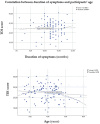The Correlation between the Results of the Sniffin' Sticks Test, Demographic Data, and Questionnaire of Olfactory Disorders in a Hungarian Population after a SARS-CoV-2 Infection
- PMID: 36769688
- PMCID: PMC9917422
- DOI: 10.3390/jcm12031041
The Correlation between the Results of the Sniffin' Sticks Test, Demographic Data, and Questionnaire of Olfactory Disorders in a Hungarian Population after a SARS-CoV-2 Infection
Abstract
Background: After a severe acute respiratory syndrome coronavirus-2 (SARS-CoV-2) infection, smell disorders frequently occur, significantly affecting patients' quality of life (QoL).
Methods: 110 patients with persistent olfactory disorder after coronavirus infection were enrolled. These patients underwent chemosensory testing using the Sniffin' Sticks test, and completed the Questionnaire of Olfactory Disorders (QOD).
Results: 30% of the patients reported anosmia, and 70% reported hyposmia. Upon comparing subjective and chemosensory testing categories, good category matching was observed in 75.3% (i.e., anosmia based on both methods in 10 and hyposmia in 48 cases). Statistical analysis using the Chi-square test revealed a significant result (p = 0.001 *). Between the TDI (i.e., Threshold, Discrimination, Identification) results of the three subjective report groups (i.e., hyposmia, anosmia, and parosmia), no significant differences were observed. When the TDI and QOD results were compared, no consistent significant correlations were found in most TDI and QOD outcomes. Between the TDI and Scale 2 results, a significant, although slight correlation was observed by the Spearman's (rho = 0.213, p = 0.027 *) and Pearson's (rho = 0.201, p = 0.037 *) tests.
Conclusions: The nonsignificant correlation between objective and subjective methods suggests that these results should be interpreted independently. Moreover, adequate management is essential even in mild cases.
Keywords: SARS-CoV-2; Sniffin’ Sticks test; olfactory disorders; patient-reported outcome measures; quality of life.
Conflict of interest statement
The authors declare no conflict of interest.
Figures



Similar articles
-
[Clinical application of Sniffin' Sticks olfactory psychophysical measurements].Zhonghua Er Bi Yan Hou Tou Jing Wai Ke Za Zhi. 2013 Sep;48(9):741-5. Zhonghua Er Bi Yan Hou Tou Jing Wai Ke Za Zhi. 2013. PMID: 24330876 Chinese.
-
Understanding the relationship between olfactory-specific quality of life, objective olfactory loss, and patient factors in chronic rhinosinusitis.Int Forum Allergy Rhinol. 2017 Jul;7(7):734-740. doi: 10.1002/alr.21940. Epub 2017 May 18. Int Forum Allergy Rhinol. 2017. PMID: 28519966 Free PMC article.
-
Statistical overview of the Sniffin' sticks olfactory test from the perspectives of anosmia and hyposmia.Sci Rep. 2025 Mar 15;15(1):8984. doi: 10.1038/s41598-025-93380-z. Sci Rep. 2025. PMID: 40089590 Free PMC article.
-
Olfactory changes after endoscopic sinus surgery for chronic rhinosinusitis: A meta-analysis.Clin Otolaryngol. 2021 Jan;46(1):41-51. doi: 10.1111/coa.13639. Epub 2020 Sep 23. Clin Otolaryngol. 2021. PMID: 32865350
-
Olfactory Outcomes after Endoscopic Sinus Surgery for Chronic Rhinosinusitis: A Meta-analysis.Otolaryngol Head Neck Surg. 2016 Dec;155(6):936-948. doi: 10.1177/0194599816664879. Epub 2016 Aug 30. Otolaryngol Head Neck Surg. 2016. PMID: 27576679 Review.
Cited by
-
Quantitive Assessment of Gustatory Function and Its Association with Demographics, and Systemic Morbidity.Biology (Basel). 2024 Jan 18;13(1):50. doi: 10.3390/biology13010050. Biology (Basel). 2024. PMID: 38248480 Free PMC article.
-
Development of a Digital Olfactory Function Test: A Preliminary Study.Life (Basel). 2024 Jan 2;14(1):75. doi: 10.3390/life14010075. Life (Basel). 2024. PMID: 38255690 Free PMC article.
-
Exploration of Olfaction and ChiPSO in Pediatric Cystic Fibrosis.J Clin Med. 2025 Apr 9;14(8):2583. doi: 10.3390/jcm14082583. J Clin Med. 2025. PMID: 40283411 Free PMC article.
-
Assessment of olfactory recovery after COVID-19: cross-sectional study.Eur Arch Otorhinolaryngol. 2024 Sep;281(9):4827-4834. doi: 10.1007/s00405-024-08646-5. Epub 2024 Apr 19. Eur Arch Otorhinolaryngol. 2024. PMID: 38641737 Free PMC article.
-
Depression, Anxiety, and Neuropsychiatric Symptom Burden in a Longitudinal Cohort with Persistent Psychophysical Post-COVID Olfactory Dysfunction.Brain Sci. 2024 Dec 19;14(12):1277. doi: 10.3390/brainsci14121277. Brain Sci. 2024. PMID: 39766476 Free PMC article.
References
-
- Lechien J.R., Chiesa-Estomba C.M., De Siati D.R., Horoi M., Le Bon S.D., Rodriguez A., Dequanter D., Blecic S., El Afia F., Distinguin L., et al. Olfactory and gustatory dysfunctions as a clinical presentation of mild-to-moderate forms of the coronavirus disease (COVID-19): A multicenter European study. Eur. Arch. Oto-Rhino-Laryngol. 2020;277:2251–2261. doi: 10.1007/s00405-020-05965-1. - DOI - PMC - PubMed
-
- Beltrán-Corbellini Á., Chico-García J.L., Martínez-Poles J., Rodríguez-Jorge F., Natera-Villalba E., Gómez-Corral J., Gómez-López A., Monreal E., Parra-Díaz P., Cortés-Cuevas J.L., et al. Acute-onset smell and taste disorders in the context of COVID-19: A pilot multicentre polymerase chain reaction based case–control study. Eur. J. Neurol. 2020;27:1738–1741. doi: 10.1111/ene.14273. - DOI - PMC - PubMed
LinkOut - more resources
Full Text Sources
Miscellaneous

